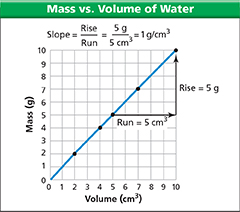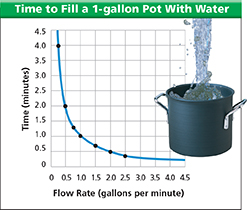Figure 21 Plotting the mass of water against the volume of water yields a straight line.
Using Graphs What does the slope represent?
 d
dFigure 22 In an inverse proportion, the product of two variables remains constant. Each point on the graph above represents the same volume of water: 1 gallon.
 d
dLine Graphs
A line graph is useful for showing changes that occur in related variables. In a line graph, the manipulated variable is generally plotted on the horizontal axis, or x-axis. The responding variable is plotted on the vertical axis, or y-axis, of the graph.
Figure 21 is a line graph that shows how the mass of water increases with volume. The data points yield a straight line. The steepness, or slope, of this line is the ratio of a vertical change to the corresponding horizontal change. The formula for the slope of a line is
“Rise” represents the change in the y-variable. “Run” represents the corresponding change in the x-variable. Note that in Figure 21, because mass per unit volume is density, the slope represents the density of water.
The relationship between the mass and volume of water is an example of a direct proportion. A direct proportion is a relationship in which the ratio of two variables is constant. For example, suppose you have a 3-cubic-centimeter sample of water that has a mass of 3 grams. Doubling the volume of the sample to 6 cubic centimeters results in doubling the mass of the sample to 6 grams. Tripling the volume to 9 cubic centimeters results in tripling the mass to 9 grams.
Figure 22 shows how the flow rate of a water faucet affects the time required to fill a 1-gallon pot. Figure 22 illustrates an inverse proportion, a relationship in which the product of two variables is a constant. If you start with a flow rate of 0.5 gallon per minute, you will fill the pot in 2 minutes. If you double the flow rate to 1.0 gallon per minute, you reduce the time required to fill the pot to 1 minute, or one half of the original time.





